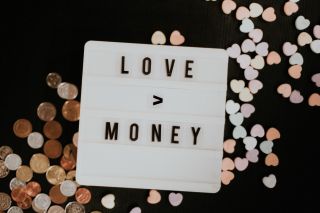Relationships
Why Valentine’s Day Stinks and How to Love It Again
The psychology of how to spend the day, our time, and our money to be happy.
Posted February 10, 2023 Reviewed by Ekua Hagan
Key points
- Half of Americans spend Valentine's Day without a romantic partner; spending it alone is common.
- Many have the mistaken impression that more people celebrate Valentine's Day with a loved one than is the case.
- One can increase their own happiness by embracing friendships, spending money on others, and buying themselves time and experiences.

Don’t fret if you’re spending Valentine’s Day solo. As a date on the calendar, an aisle in the Hallmark store, and a theme for candy makers, our social environment makes us feel like we are supposed to spend February 14 lavishing people with gifts. The commercial hype fosters expectations for the day, one of which is the mistaken belief that we are supposed to spend money. Lots of money. According to research conducted by the Federal Retail Federation, more than half of U.S. consumers plan to spend money on candy, gift cards, flowers, jewelry, and other items topping $26 billion.
On Valentine’s Day, it might feel like absolutely everyone is out celebrating with a love interest. But that’s not true. In fact, only about 1 in every 2 Americans this year plan to celebrate Valentine’s Day at all, recent projections show. If you’re riding out the day and night alone, rest easy because about half the country is too.
We think we’re supposed to hunker down on Valentine’s Day with a loved one because of a psychological phenomenon known as pluralistic ignorance, a term coined in the mid-1990s by esteemed social psychologists Deborah Prentice and Dale Miller. We believe others around us hold certain beliefs–maybe about who to be with and how to spend February 14. But perceived norms can differ dramatically from actual social norms.
We think more people are celebrating with a loved one than actually are for a few reasons. First, we have an easier time seeing the people who are taking dates out to dinner, schlepping bouquets of roses around after work, searching shelves for chocolates, or smooching under a heart-shaped garland. We don’t see the people who are eating dinner with their platonic roommates at home like they do every other Tuesday of the year. We don’t pay attention to the people without bouquets of flowers. We don’t see the gifts that are not in people’s hands. Noticing the presence of things is far easier than noticing the absence of them.
Second, it’s quite possible that people privately reject the expectations or social conventions for how to spend the holiday. But it’s hard to know what others think. We are often incorrect about most people’s private sentiments. We overestimate the degree to which others want to and will buy gifts and cozy up to a romantic partner for the evening. These factors come together to lead to the mistaken assumption that, if we find ourselves alone or choose to spend it solo, somehow we are doing the holiday wrong. And that can feel bad.
So what can we do to make Valentine’s Day suck less? Here are a few scientifically-backed suggestions.

Embrace Companionate Love
Replace Valentine’s Day with Gal-entine’s Day or Pal-entine’s Day. As Leslie Knope from the hit television show Parks and Recreation offered, “every February 13, my lady friends and I leave our husbands and our boyfriends at home and we just come and kick it, breakfast-style… ladies celebrating ladies.” Fostering affectionate, friendship-based love and attachment is good for the soul and the body. Characterized by interdependence and durable feelings of affection, intimacy, and commitment, researchers at Harvard University discovered that companionate love releases oxytocin. This is the same hormone that comes during sex, breastfeeding, childbirth, and other activities that foster long-term bonding. Spending time with friends–sharing pancakes or just each other’s company–can give you the same rush as a good round of whoopie.
Call Someone
Pick up the phone and make a call. Don’t send a text. While for some of us, we’d rather die than talk to a person using a telephone, our fear of reaching out is the result of risk aversion. But connecting with others helps us feel better and decrease loneliness. Social psychologists Amit Kumar and Nick Epley studied the impact of communication styles when rekindling connections with long-lost friends. They found that we hold an unwarranted fear of phone calls. We worry about awkward pauses and indecision about when to hang up. We mistakenly believe that text messages relieve us of social anxieties. Text-based communication, however, does less than we expect to actually promote social connection given its superficiality and the ease of misinterpreting someone’s intentions. When we talk to each other, we receive a richness of intonation and tones and pauses that can signal intimacy and vulnerability. These are the things that give rise to social closeness.

And better yet, make that call on a landline, not a smartphone. Smartphones are distracting. They prevent us from paying attention to others around us. Georgetown University psychologist Kostadin Kushlev found that smartphones reduced smiles between strangers. Even casual conversations like those we have with a Starbucks barista can improve mood, but when we are engrossed in our phones, the odds of starting up a quick chat are low.
Buy Yourself Time
If you are going to spend money this holiday, spend it on yourself, particularly in ways that help you avoid doing things you don’t want to do. In other words, buy yourself out of the tedium of everyday life.
A team of behavioral scientists led by Ashley Whillan at Harvard Business School reported in a 2017 study that buying ourselves time can make us happier. The research team surveyed over 6,000 people in the United States, Canada, Denmark, and The Netherlands and found that individuals, including people of moderate wealth and even millionaires, who spent about $80 to $100 a month on time-saving services like buying themselves out of cooking, shopping, or household chores reported greater life satisfaction.
Buy Yourself Experiences
If you open your wallet, do it to buy experiences instead of material goods. Rather than purchasing a new watch, sweater, or the latest iPhone, spend money on an event or activity, like a concert, comedy show, or relaxing weekend getaway. The return on investment—or at least on your happiness—might be greater. A 2020 survey found that purchasing events and activities instead of material goods boosted happiness just one hour after purchasing and sustained happiness long after the events or activities occurred. Anticipation of the experience, higher enjoyment while engaging with the experience, and greater remembered satisfaction when replaying memories of the experience all work together to keep that mood boost up.
Buy Other People Things
Another way to buy yourself happiness on Valentine's Day is with some good old-fashioned charity. Valentine’s Day can often feel like a soulless cash grab. Spending money on others—what psychologists call prosocial spending—can be a great way to use Valentine’s Day as a celebration of a broader kind of love, a love for humanity as a whole.
Scientists at the University of Chicago studied more than 500 people who performed random acts of kindness. Givers failed to anticipate just how much of a hedonic impact gifts like these would have on other people. Receivers reported a higher level of happiness than givers expected. Givers underestimate the value of their giving. They pay too much attention to the value or cost of the act itself and pay too little attention to the warmth conveyed directly through the act of kindness.

Mood boosts aren’t just selfless experiences. Psychologist Lara Aknin found that people who purchased a goody bag for patients at a children’s hospital rather than buying it for themselves reported immediate increases in their own happiness. Buying for others, even strangers, can create happiness for the giver too.
So, if the idea of Valentine’s Day has you in a slump, remember, it’s just one day, and perhaps all you need to get through those 24 hours is to ride out the short-term wave of happiness that comes from knowing you did a good deed.
This piece was collectively written by members of the New York University Social Perception Action and Motivation research lab including Emily Balcetis, Henry Biedron, Rheanna Ganapathy, Shan Gao, Genna Goins, Ainsley Hoh, Cat Howard, Nora Kahl, Usman Liaquat, Thy Nguyen, Gracielle Resurreccion, Bradley Tao, Ashley Winegarden, Siyang Shen.




